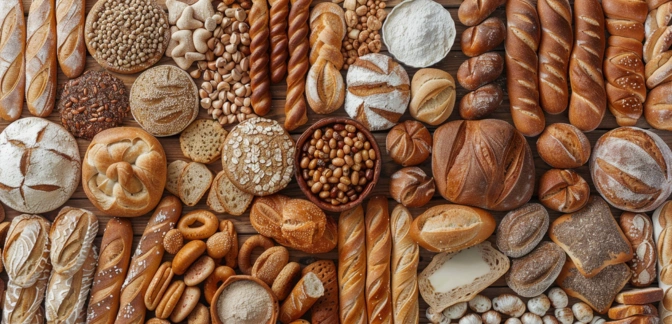Wheat Flour — Nutrients, Health Benefits, And Shopping Tips

Written by Listonic Team
Last update on September 4, 2024
Wheat flour nutrients
Nutrition facts
Amount per 100 g
Calories
🔥 340 kcal
| Nutrition per: 100 g | Value | % Daily Value* |
|---|---|---|
| Carbs | 72 g | 26.18% |
| Fiber | 11 g | 39.29% |
| Sugars | 0 g | - |
| Glycemic Index | 85 | - |
| Protein | 13 g | 26% |
| Sodium | 2 mg | 0.09% |
| Total Fat | 1 g | 1.28% |
*The % of Daily Value (DV) tells you how much a nutrient in a serving of food contributes to a daily diet. 2,000 calories a day is used for general nutrition advice.
11 g
✅ High Fiber Content
13 g
🧀 Good Protein Content
Wheat flour facts & tips
Health benefits
- Rich in essential vitamins and minerals such as B vitamins (especially B1, B3, and B9), iron, magnesium, and zinc, which support overall health and well-being.
- Provides sustained energy from complex carbohydrates, making it a good source of fuel for the body and brain.
- Contains dietary fiber (especially whole wheat flour), promoting digestive health, regular bowel movements, and maintaining a healthy gut microbiome.
- Supports healthy metabolism due to its content of B vitamins, which are essential for energy production and metabolic processes.
Health risks
- High carbohydrate content particularly in refined wheat flour, which can cause rapid spikes in blood sugar levels, particularly concerning for diabetics.
- Potential for gluten content making it unsuitable for individuals with celiac disease or gluten sensitivity, potentially causing digestive discomfort and other health issues.
- Low nutrient density as refined wheat flour offers limited vitamins and minerals compared to whole grain flour.
- Potential for overconsumption due to its versatile use in baking and cooking, leading to excessive calorie intake if not mindful of portion sizes.
How to choose wheat flour
Wheat flour should be uniform in color and finely ground. When pinched, it should clump lightly but break apart easily, suggesting it's properly milled. The flour should have a fresh, neutral smell, ideal for baking.
Avoid wheat flour that smells sour or appears discolored, as these can indicate spoilage or contamination. Flour that feels damp or shows signs of insect activity should also be avoided, as it is not suitable for use.

How to store wheat flour
Wheat flour should be stored in an airtight container in a cool, dry place. Proper storage keeps it fresh and prevents it from absorbing moisture or odors. Flour can be refrigerated or frozen for longer shelf life.
Exposure to moisture and heat can cause flour to spoil and develop a rancid odor. Avoid storing it near strong-smelling foods, as it can absorb unwanted odors. Ensure the container is tightly sealed to maintain its quality.
✅ Extra Tip
How long does it last?
Wheat flour can last for 6-8 months when stored in an airtight container in a cool, dark place. Whole wheat flour has a shorter shelf life of about 4-6 months. For longer storage, flour can be kept in the refrigerator or freezer, where it can last up to 1 year.
What to do with leftovers?
Leftover wheat flour can be used in a variety of culinary and non-culinary ways. In the kitchen, wheat flour is essential for baking and cooking, used in making breads, cakes, pastries, sauces, and coatings for frying. Flour can also be used to thicken soups and stews or to make roux for rich, creamy sauces.
Beyond cooking, wheat flour has several practical uses. It can be used in DIY beauty treatments, such as mixing it with water to create a natural face mask that helps absorb excess oil. Wheat flour can also be sprinkled on hands and surfaces to prevent dough from sticking when working with sticky substances, such as play dough or crafts. Additionally, flour can be used as a natural cleaner for polishing stainless steel; simply apply a small amount to a soft cloth and buff the surface to remove fingerprints and smudges. Wheat flour can also be used to create homemade glue or paste for craft projects.
👨⚕️️ Medical disclaimer
Discover products from other categories
Listonic Team
Fact-checked
Our editorial team checked this article to make sure it was accurate at the time of publishing it.
Get the top-rated shopping list app

wheat flour
1 piece
Outline







